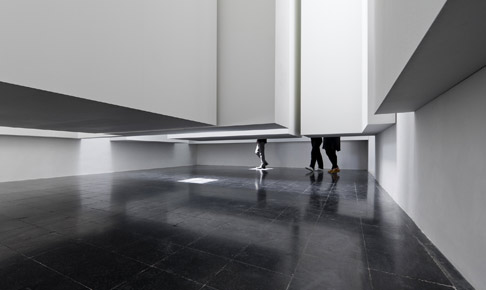ARTEXT : La Biennale di Venezia
54 Esposizione Internazionale d'Arte
Giardini di Castello - Austria
Markus Schinwald
Markus Schinwald
With his work for the Biennale, Markus Schinwald has used spatial constriction to create spatial
expansion – a paradox pervading his artistic oeuvre. He also introduces an unusual horizontal
division, which begins at crotch height. Physically palpable and unsettling, this caesura becomes
the moment of torsion between uncontrollable expanse and choreographed constriction.
The dissection of the upper space along vertical axes gives rise to a new form of perception, one
that takes the human body as the reference point for its articulation, yet also adds a sense of
uncanniness through the disproportional ceiling height. As a result, the fractures, the disruptive moments that Schinwald’s works otherwise inscribe in the human body here reappear in threedimensional
space. Hanging cubes, inserted walls, niches, long corridors leading nowhere, and the
natural light that falls from above into the oversized chasms of the passageways shape this journey
of discovery between the hidden and the visible. It’s an arena that closely matches the topography
of its location – reflecting Venice, a maze of alleyways and sunken roads.
Yet when he describes the structural elements, Markus Schinwald prefers to use the terms of
psychoanalysis. The space he creates is a dissociative rather than a genuinely fragmented one:
claustrophobic above, nothing below. Or, as he puts it, the head in neurosis, the crotch in
psychosis.
In his Biennale work, Schinwald confidently combines architectural elements with pictorial,
sculptural, and filmic or performative ones. He subtly explores the dispositifs of control, discipline,
and self-correction. These are inscribed in the human body, shaping and permeating it; they
reemerge on the body surface, in visible and tangible form, as psychologically charged inner
worlds. For his new two-part film, entitled Orient, Schinwald recreates the Austrian Pavilion
entrance in model form, and the situation he has contrived offers him a means to coerce the body.
The vertical abysses on display thus become a showplace for inadequacy and compulsiveness.
In the framework of Bice Curiger’s general theme ILLUMInations, Markus Schinwald negotiates the
representation and manipulation of space, time, light, and shadow. He not only alters our
experience of space through an element of disturbance, but also allows the Austrian Pavilion’s
architecture and history to stand and makes it his subject – with all its ruptures, rifts, and
blemishes.
At the core of Schinwald’s art is the psychological confrontation with space and body, the uncanny
and the discomfiting, the deficient and the irrational depths of individual and collective being. His
observing eye focuses on the human body with all its idiosyncrasies, and on the sociocultural
environment in which that body is embedded. By binding the distanced, passive viewer to the
spatial and temporal context, Schinwald makes the spectator a protagonist, someone who sees
actively and is given the opportunity, through emotionalized experience, to develop and pursue
individual analogies and storylines. The carefully positioned paintings and sculptures pick up new
narrative threads and emphasize the denseness of the void.
The space expands outward, a storytelling babel of voices commences – and the labyrinth begins to
float.
Curatori : Eva Schlegel
Artisti : Markus Schinwald
Web site : http://www.labiennale.at |

